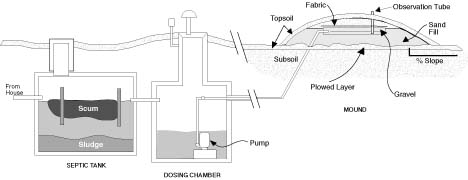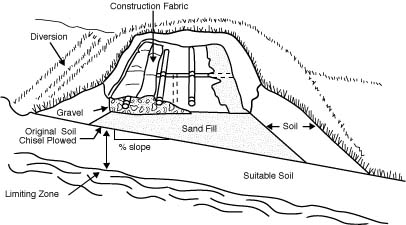

Septic tanks with soil absorption systems are the most commonly used wastewater treatment system in rural and suburban areas. All septic systems consist of two parts: the septic tank and the soil absorption system. The septic tank settles and stores sewage solids. The clarified liquid that flows out of the tank is called septic tank effluent. The septic tank effluent is then treated and disposed of in the soil absorption system.
Unfortunately, in many rural areas, soils with shallow depth
over a limiting layer or soils with a high percolation rate make it
impossible to use a conventional subsurface soil absorption system for
wastewater treatment and disposal. On these problem sites, mound
systems may be an alternative. Site limitations for both subsurface
soil absorption systems and mound systems are compared in the table.
| Comparison of site limitations for subsurface soil absorption systems and mound systems. | ||
|---|---|---|
| Site Limitation | Mound System | Subsurface Soil Absorption System |
| Depth to limiting layer (inches) | at least 24 | at least 60 |
| Percolation rate (min/inch) | More than 3 but less than 120 | More than 3 but less than 60 |
| Slope | Less than 15% | Less than 15% |
In a mound system, specially selected sand is placed on top of the natural soil to help treat and dispose of septic tank effluent. The depth of sand is determined by the depth of the natural soil above a limiting layer. A limiting layer can be bedrock, a soil layer with a very low percolation rate, or seasonally high groundwater. The depth of sand added to the depth of the natural soil must equal the minimum legal treatment depth, typically about 4 feet (130 cm).
In a mound system, septic tank effluent is delivered to the mound with a pump in a dosing tank placed after the septic tank as shown in the first illustration. The mound itself is carefully constructed above ground.

A mound is constructed in layers of predetermined depth, as shown in the second illustration. First, the depth of the natural soil to the limiting layer is determined. The natural soil depth above a limiting layer should be a minimum of 24 inches (60 cm). A layer of specifically sized sand is placed on top of the natural soil, so together they equal the minimum required soil depth of 4 feet. A layer of gravel surrounding the pipes for the pressure dosed distribution system is then placed on top of the sand. Finally, after covering the gravel with construction fabric, a layer of soil is placed over the entire mound to protect the mound from freezing. The layer of soil is also needed for growing grass or other non-woody plants that control erosion. Trees and shrubs should not be planted on a mound because roots tend to clog pipes in effluent distribution systems, and they can damage the geotextile construction fabric. The sides of the mound are sloped to make it convenient and safe to mow.

Appropriate techniques are necessary for an efficient mound construction project. The site for the mound must be carefully prepared. The grass is mowed and leaves raked away. Trees and shrubs are cut off at ground level, with the roots left in place. The area for the mound is then chisel-plowed to roughen the surface in preparation for the sand layer. Avoid compacting the soil under and just downslope of the mound as the sand, gravel, pipe and soil are put into place. Work should always be done from the upslope side (or from only one side on flat lots) using lightweight tracked vehicles. Following construction, a diversion ditch may be needed just upslope from the mound to divert surface runoff around the mound.
As with all on-site sewage systems, the homeowner must
maintain the system to ensure trouble-free operation. The homeowner
should:
(1) Pump the septic and dosing tanks every 1 to 5 years.
(2) Use water wisely and install water saving devices in the home.
(3) Never compact the soil downslope of the mound by paving,
constructing a building or parking cars.
(4) Do not plant trees or shrubs on the mound to avoid clogging pipes
with roots.
Depending on the cost of sand and the amount of labor involved, mound systems are usually twice the cost of a comparably sized subsurface soil absorption system. The higher cost is necessary, however, if the site or soil condition makes it impossible to use a subsurface soil absorption system. A mound system permits a home to be occupied in a rural area while still protecting the environment.
You will find many more articles that tell you how to live with your septic tank here.